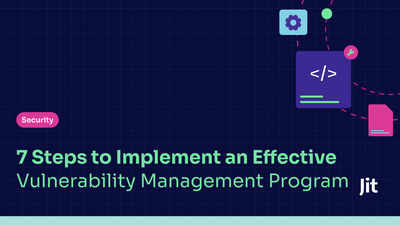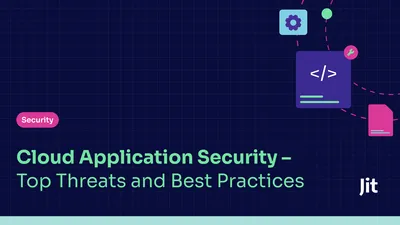Application Security: Tools, Tips, & Best Practices
In this guide to application security, learn about the key vulnerabilities to look out for, how to catch them with our favorite AppSec tool, and how to implement these tools to empower your developers.

What is Application Security?
Application Security (AppSec) involves practices, tools, and technologies designed to protect applications from threats throughout their entire lifecycle––this means from their design phases, through their coding phases all the way through to their deployment and runtime in production. This also includes the teams and culture tasked with securing software from development through deployment and maintenance. The goal of AppSec is to identify and mitigate vulnerabilities that could be exploited by attackers to gain unauthorized access to systems, data, and other sensitive information.
AppSec integrates security measures into the software development process at different insertion points, ensuring that applications are built with security in mind from the ground up. This proactive approach helps organizations defend against a wide range of threats, including those targeting web applications, mobile apps, cloud applications, their APIs, as well as the infrastructure they run upon.
Common Risks in Application Security
Applications face numerous security risks that can lead to data breaches, financial losses, and reputational damage. One very handy list of the most popular and commonly exploited threats is the OWASP Top 10 list that exists from the early 2000s, to help engineering teams identify known risks when writing their applications.
Some of these common risks include:
Injection Attacks: Malicious code is injected into an application, often through user inputs, leading to unauthorized actions such as data leaks or system compromise.
Cross-Site Scripting (XSS): Attackers inject malicious scripts into web pages viewed by other users, potentially stealing cookies, session tokens, or other sensitive data.
Broken Authentication: Weak or misconfigured authentication mechanisms allow attackers to gain unauthorized access to user accounts.
Security Misconfigurations: Improperly configured security settings can expose applications to various threats.
Insecure Deserialization: Deserialization of untrusted data can result in remote code execution or other attacks.
Insufficient Logging and Monitoring: Lack of adequate logging and monitoring makes it difficult to detect and respond to security incidents.
What is Shift Left in Application Security?
One buzzword we constantly hear in the context of cybersecurity, and specifically Application Security, is “shift left”. So what does that actually mean?
"Shift left" is a concept in software development that emphasizes the importance of integrating security measures as early as possible in the development lifecycle. Historically, before shift left practices became popularized, security testing and reviews occurred near the end of the development process––when most of the coding work has already been completed and changes become quite costly to engineering organizations. By shifting security left, organizations can identify and address vulnerabilities sooner, reducing the cost and effort required to fix them.
Shift left introduces key aspects to enable greater integration of security into the SDLC (software development lifecycle):
Early Testing: Incorporating security testing from the initial stages of development.
Continuous Integration: Automating security tests within the CI/CD pipeline.
Developer Training: Educating developers on secure coding practices to prevent introducing vulnerabilities.
How Does AppSec Relate to DevSecOps?
AppSec and DevSecOps are closely related, with DevSecOps being an extension of DevOps that incorporates security practices into every phase of the software development lifecycle. DevSecOps aims to break down silos between development, operations, and security teams, fostering a culture of collaboration and shared responsibility for security.
Key principles of DevSecOps include:
Automation: Integrating security tools and processes into automated CI/CD pipelines.
Collaboration: Encouraging communication and cooperation between development, operations, and security teams.
Continuous Monitoring: Implementing continuous security monitoring to detect and respond to threats in real-time.
Security as Code: Treating security policies and configurations as code that can be version-controlled and audited.
AppSec and Regulatory Compliance
Many organizations today, in order to achieve market penetration and product assurance, are required to comply with leading industry regulations and standards such as SOC2 or GDPR. These relate to Application Security (AppSec), as the security of your application stacks play a crucial role in helping organizations meet regulatory compliance requirements.
Regulatory bodies across various industries have established guidelines and standards to ensure the security and privacy of data to prevent data leakage and breaches that can be exploited by malicious actors. AppSec practices are essential for adhering to these regulations, and you can learn more about the diversity of regulations and frameworks for security practitioners.
The key aspects of AppSec that often related to regulatory compliance include:
Data Protection: Ensuring that sensitive data is protected from unauthorized access and breaches. Regulations like GDPR, CCPA, and HIPAA require organizations to implement robust data protection measures.
Vulnerability Management: Regularly identifying and mitigating vulnerabilities in applications. Standards such as PCI DSS mandate vulnerability scanning and management as part of their compliance requirements.
Access Controls: Implementing strict access controls to ensure that only authorized users can access sensitive information. Regulations often require role-based access controls (RBAC) and multi-factor authentication (MFA) to enhance security.
Logging and Monitoring: Maintaining detailed logs and monitoring application activity to detect and respond to security incidents. Compliance frameworks like ISO/IEC 27001 emphasize the importance of logging and monitoring for security and audit purposes.
Secure Development Practices: Adopting secure coding practices and conducting regular security training for developers. Regulatory standards frequently require organizations to follow secure development guidelines to minimize risks.
Audit Trails: Keeping comprehensive audit trails to provide evidence of compliance and facilitate investigations in case of security incidents. Regulatory bodies often require maintaining records of security-related activities and changes.
By integrating AppSec practices into your software development lifecycle, you can ensure that your applications not only remain secure but also comply with relevant regulatory standards. This proactive approach helps mitigate the risk of non-compliance penalties and enhances the overall security posture of your organization.
Popular Tools for AppSec
As noted above, due to the breadth of the application security domain, many tools have arisen over many years to concentrate on different aspects of your application’s security lifecycle, as noted from the coding, to the CI/CD and deployment, through runtime and post-deployment (essentially continuous security). We have written extensively about application security tools, and when to use them.
Below is just a short list of the popular tools employed today to provide greater application security coverage across the full stack:
Static Application Security Testing (SAST): Analyzes source code for vulnerabilities during development.
Dynamic Application Security Testing (DAST): Tests running applications for security issues by simulating attacks.
Interactive Application Security Testing (IAST): Combines elements of SAST and DAST by analyzing applications in real-time during testing.
Software Composition Analysis (SCA): Identifies vulnerabilities in open-source libraries and third-party components.
Secret Detection: Scans for hardcoded secrets, such as API keys and passwords, in the codebase. Detecting and removing these secrets helps prevent unauthorized access.
IaC Security Scanning: Analyzes Infrastructure as Code (IaC) templates for security vulnerabilities and misconfigurations. These tools ensure that infrastructure is securely provisioned from the start.
Software Bill of Materials (SBOM): Generates an inventory of components, libraries, and dependencies used in software. SBOM tools help track and manage third-party components to ensure security and compliance.
Container Scanning: Scans container images for vulnerabilities and misconfigurations. Ensuring the security of containerized applications is critical in modern DevOps practices.
Application Security Posture Management (ASPM): Continuously monitors and manages the security posture of applications. ASPM tools help ensure that applications adhere to security best practices and compliance standards.
How Can I Get Started with Securing My Applications?
Application Security, like all domains, requires time to gain deeper understanding and expertise, however, getting started today is easier than it once was. With the many available resources, communities, open source tools and much more––it’s now possible to ramp up your AppSec knowledge while having a strong and supportive community.
Educate Your Team: Train developers on secure coding practices and common vulnerabilities.
Integrate Security Early: Adopt a shift left approach by incorporating security testing from the initial stages of development.
Automate Security Testing: Use tools like SAST, DAST, and SCA in your CI/CD pipeline to continuously test for vulnerabilities.
Conduct Regular Audits: Perform periodic security assessments and code reviews to identify and address vulnerabilities.
Monitor and Respond: Implement continuous monitoring to detect and respond to security incidents in real-time.
Adopt a DevSecOps Culture: Foster collaboration between development, operations, and security teams to ensure security is a shared responsibility.
The Product Security Platform
Jit empowers developers to secure everything they code. Get full coverage in minutes by unifying SAST, SCA, secrets detection, IaC scanning, DAST, and other product security controls.
Recommended AppSec Communities and Resources
Getting involved with AppSec communities and utilizing available resources can greatly enhance your knowledge and effectiveness in securing applications. Below are some recommended communities and resources:
OWASP (Open Web Application Security Project): A nonprofit foundation that works to improve the security of software. OWASP provides a wealth of resources including the OWASP Top 10, various tools, and community events.
DevSecOps Community: A community that focuses on integrating security into DevOps practices. They offer forums, meetups, and resources for learning and collaboration.
SANS Institute: Offers training and certifications in cybersecurity, including application security. They provide courses, webinars, and other educational resources.
Security Weekly: A collection of podcasts, blogs, and webcasts covering various aspects of cybersecurity, including application security.
Reddit r/netsec: A popular subreddit for discussing network security topics, including application security. It's a great place to ask questions and share knowledge.
Security Conferences: Attending conferences like Black Hat, DEF CON, the global BSides grassroots events, OWASP events, and RSA Conference can provide valuable learning opportunities and networking with other AppSec professionals.
By engaging with these communities and utilizing these resources, you can stay up-to-date with the latest trends, tools, and best practices in application security.
Application Security Posture Management (ASPM) and Application Security
Application Security Posture Management (ASPM) is an emerging category of tools that provides continuous visibility into the security posture of applications. ASPM tools like Jit, monitor applications throughout their lifecycle, from development to deployment and beyond, ensuring that security best practices are consistently applied. Jit’s platform is built to make security a first-class citizen and provide the tools to foster a culture of shared responsibility for engineering teams. By building an ASPM that focuses on the same quality metrics as IDPs (internal developer portals) that platform engineers today care about, where security is just another category that measures your product quality; security will become a native part of the application lifecycle that developers care about.
By integrating with existing development and deployment pipelines, ASPM tools can automate the detection and remediation of vulnerabilities, enforce security policies, and provide comprehensive reporting and analytics. This holistic approach to application security enables organizations to proactively manage risks, maintain compliance, and respond quickly to emerging threats. ASPM enhances the overall security framework by offering a centralized, continuous monitoring solution that aligns with modern DevSecOps practices, thereby ensuring that security is an integral part of the application lifecycle.
Conclusion
Application Security is the security practice and domain charged with protecting applications from a wide range of threats throughout their lifecycle. By understanding common risks, embracing the shift left approach, and integrating security into DevSecOps practices, organizations can build more secure applications and maintain a strong security posture.
Leveraging the right tools and fostering a culture of security awareness among development teams are essential steps in achieving robust application security. We at Jit believe security is just another measure of application quality, and an inherent part of the SDLC––once all engineering teams will embrace this, AppSec will improve across the entire industry.
Latest Application Security Articles






